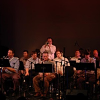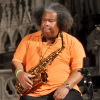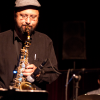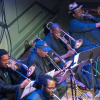Home » Jazz Articles » Extended Analysis » Warriors of the Wonderful Sound: Soundpath
Warriors of the Wonderful Sound: Soundpath
Many years later, Bobby Zankel, who himself moves readily between the mainstream and avant-garde and has had considerable experience with Abrams, asked him to be a guest leader of his illustrious and adventurous Philadelphia-based big band, the Warriors of the Wonderful Sound. Thus it was that in 2012, Abrams himself led the Warriors in a rare performance of his groundbreaking composition, "Soundpath," which he had written over a long period of time for a large ensemble with composed sections seeded with numerous opportunities for improvising. The work was performed at Montgomery County Community College, with everyone— musicians and audience alike—excited by the result. However, lacking a recorded version, the difficult-to-play score of this rarely heard work then went back into the file cabinet of time.
Abrams passed on in 2017, and perhaps as a memorial to him, Zankel seized an opportunity provided by Ars Nova Workshop for the Warriors to once again perform Soundpath, this time at the 2018 "October Revolution" concert in a hall adjacent to Christ Church in the Old City neighborhood of Philadelphia. Zankel recruited one of Abrams' most dedicated long time associates, Marty Ehrlich, to lead the performance, and they brought in specially chosen musicians to supplement the Warriors personnel in realizing this very challenging work. Ehrlich has immersed himself in the jazz scene since the 1970s and has played a major role in the development of the avant-garde. He brought out the best in the musicians, had a perfect sense of timing, and organized the band and the varied sections of the piece into a unified whole. Once again, everyone was stunned by the complexity and beauty of what emerged, marveling both at the capabilities of the musicians and the ways that the intentions of the composer and the musicians seemed to fuse into a unity of the highest level of musical import. Still, the one thing missing was a recording.
The Recording of Soundpath
Here was groundbreaking music, but few would ever be able to hear it, unless—again thanks to Ars Nova's sponsorship—the band was able to go into a recording studio under optimal conditions and do a single, 40+ minute track of the whole piece, so that this rarely heard music could be made available to a larger audience of musicians and music lovers around the world. Indeed, this recording was made on October 8, 2018, a day after the concert, at the Drexel University Recording Studio with recording engineer Eric Carbonara and editing, mixing and mastering by Brian Montgomery. The recording was released in November, 2019, a little over a year after the recording date, by the Portuguese label Clean Feed.Such a novel and stimulating recording cries out for a review. However, it should also be said as a caveat that the music is so unique, original, and spontaneous that any review can hardly pretend to be the last word on the subject, much less capture its essence. Yet it calls out strongly to be reviewed because it is a musical event signaling some of what jazz can become if it stays close to its African and African American roots yet dares to utilize European and world music to catapult into wider dimensions of musical expression. In this respect, through its fusing of jazz and classical forms, Soundpath can be thought of as a development of so-called Third Stream jazz, yet in some ways, it defies all categorization. So what can we say about it other than that it is a singular achievement that deserves the attention of the jazz community?
Let's start with a broad brush overview. Soundpath has many orchestrated sections, openings for solos, and free form opportunities, creating clear structures as well as the freedom for the band to go its own way, an ideal combination for any jazz ensemble. It incorporates much of the avant-garde, but there are also sections that sound like Count Basie, Duke Ellington, or Maynard Ferguson, and at times there are echoes of the early bands like King Oliver and Fletcher Henderson. Some parallels could also be drawn to the Charles Mingus Big Band with its grinding pulsations, and at the "far out" end, you could hear passages reminiscent of John Coltrane's deep space explorations.
Perhaps the most striking characteristic of the composition is emhodied in its name, "soundpath," a pathway of sound. Most western music, and much music from other cultures, is based on repetition or recurrence. A theme is stated, and then repeats itself or recurs in variations. A "path," however does not go back to the original location, but moves on, renewing itself by anticipating what is in front of it and moving towards a goal, a new place. That is what is most striking about Soundpath: it moves forward in a constantly flowing motion, without repeating or varying what went before. In that respect, it is very Zen -each moment is unique in itself.
In terms of trends in composition for large jazz ensemble, Soundpath is the full embodiment of a tendency to merge pre-composed material with improvisation without the sharp distinction between written ensemble parts and choruses given to solo improvising. The piece is largely re-composed by the musicians each time it is played. Abrams might put an idea down on staff paper, and then allow the section members to improvise on it, whether as individuals or an ensemble. To keep this from descending into chaos, you need musicians of the highest skill and experience who take pleasure in moving off the grid and experimenting. The Warriors are optimally suited for such work, and bringing in musicians like Ehrlich specifically familiar with Abrams' work further assured that it would be faithful to the master's intent.
Impressionistic Description of the Recording
Because of the freshness and novelty of the composition and the special twists brought in by each of the musicians, descriptions of the recording are apt to vary depending upon the listener's predilections. You might hear things differently. That said....The piece begins with some disturbing dissonances, out of which pianist Tom Lawton creates a striking piano solo that has echoes of modern composers like Messaien or Poulenc. We are off on an adventure. Lawton's solo then takes us into a dialogue among the saxophonista. There is some remarkable counterpoint between them, and it's your guess as to whether it is composed or improvised. Then the trumpets and trombones come in as whole sections with very listenable harmonies leading up to an alto saxophone solo and then trumpet picking up on similar ideas only in a more laconic way. Then we hear some bolder, faster, playing, and a brief "tear jerker" conclusion. Next is a brass ensemble "conversation" with a trumpet lead. The trombones come in to lend their point of view. Then there is more brass plus reed choir and more movement building to a motion-generating piano solo supported by Chad Taylor on drums and Michael Formanek on bass. Suddenly, there is quiet, and the saxophone and bass sound a bit like musicians from Harlem trying out a new way of playing. The piece then moves on to a soprano saxophone and bass "duet."
Next there is a brass choir and some high register interactions by soprano saxophone and trumpets leading to a soprano sax solo in an otherwise empty space with the trumpet and then the tuba entering in. The interactions begin to sound like parts of Stravinsky's The Rite of Spring, which may have influenced Soundpath in more ways than one. Then we hear some very interesting machine-like sounds interspersed with trombone and a return of the conversational element. An extended bass solo by Formanek explores the intervallic structure of the whole piece. Lawton joins in on piano with a low register motif and Graham Haynes on cornet gives a clearly "jazz" style solo backed by piano in an even lower register. Then there is an extended improvised trombone solo with a mysterioso feeling, which is taken over and extended by alto saxophone. Jose Davilla solos for a moment on tuba and is then accompanied by a light Latin style drumming, and then there are some unearthly sounds you may never have heard before, made by saxophones that sound like computer generated speech. A feeling of a march is provided by trombones and trumpets. A bit of Charles Ives' street band music in Three Places in New England is hinted at here. Now a trumpet provides a solo accompanied by bass and percussion. Lawton's piano and Mark Allen's baritone saxophone come in for a conversation. Time is then marked by the trombone section, and the trumpets add some melodic motifs. Soundpath is brought to an end by a "straight ahead" drum solo that gives all the sections a chance to chime in individually or in a group. Lawton's piano, followed by a big band ensemble series of riffs takes us out.
Description and Analysis by Conductor Marty Ehrlich
"Soundpath has six composed sections. These sections build in complexity within themselves, using a fascinating array of compositional gambits. These notated sections are related by tempo and by numerous uses of temporality, rhythmic and architectural. But the effect is always one of forwarding motion. The musical language is constantly evolving. It points to an infinity, if you will, mapped by Muhal's highly personal language of interval and chordal structure, all filtered and sifted through one of the most exquisite musical ears we know. Within and around these composed sections, you hear the members of the Warriors of the Wonderful Sound enlarge upon this evolution in solo and collective improvisations. We start this recording with a piano trio improvisation, as Muhal had done in his live performance with the Warriors of the Wonderful Sound. Each realization of Soundpath will be unique concerning how improvised material and notated, pre-composed material will connect and interact."When put under a microscope, you see the large range of compositional techniques Muhal employs. Phrases overlap without a set pattern but share the same temporal length. These phrases may then share phrase length but not a set rhythm or melodic shape. Everything morphs and evolves. The compositional counterpoint goes from two to six independent lines at a time. These lines are reinforced diversely by the orchestration, by doublings within each instrumental family of the orchestra saxophone/trombone/trumpet/rhythm section), and at times by orchestrations over the instrumental families. The work is a cornucopia of possibility in this regard. The one exception to this is open evolution is the ending of the work. The last pages of the score return to the tempo, and the first composed pages' open swing feel. With a nod to past masters, the music builds to a drum solo and a full orchestral conclusion.
"Muhal asked a lot of his performers. This piece is no exception. The instrumentalists are asked to work as full sections in the tradition, deeply African, of setting choirs of like horns, saxophones/trombones/trumpets, and the rhythm section in interlocking relations, a large drum choir. (Thank you Count Basie) Simultaneously, each performer is asked to step out as interpretive individuals, with solo lines not doubled by other instruments, melodic lines that connect into one long shaping, an instrumental role similar to that required in a Eurological orchestral work.
"What I describe above refers to the area of performance practice. It does not in any way describe the musical entity of Soundpath. Think of this work on a continuum, and think of Muhal's diversity of endeavor in that continuum. Muhal was a master of historical styles in African-American musical culture, a composer of evocative works in jazz, blues, and gospel traditions, to use terms connected to the music business. However, his work is never that of a straight historical narrative. From his earliest years, Muhal is working on his voice, his soundpath. He is rethinking all he knows about music to come to something that looks toward the new, that adds to the new. In conversations with Muhal in his last decade and more, he would speak to individuality as a prime goal in life and art. In almost every conversation, he spoke with excitement about art he had recently heard or saw. He took individuality as a given. It is an individuality of great collectivity. You do not own it; you activate it. With Soundpath, we hear a work that comes from a lifelong curiosity and a never-tiring intellect, a lot of hard work, and a deep reservoir of talent. You may need to jump, but please jump on in."
To conclude, Soundpath is a groundbreaking recording that stretches and elaborates upon various 20th century developments in jazz and classical music. It incorporates new ways of combining written composition with improvisation. It is also a testament to its composer, Richard Muhal Abrams, and his major contribution to the jazz world and repertoire.
Track Listing
Soundpath: One track for entire composition.
Personnel
Warriors of the Wonderful Sound
band / ensemble / orchestraMarty Ehrlich
woodwindsBobby Zankel
saxophone, altoJulian Pressley
saxophone, altoRobert DeBellis
saxophone, tenorHafez Modirzadeh
saxophone, tenorMark Allen
saxophone, baritoneDave Ballou
trumpetDuane Eubanks
trumpetGraham Haynes
cornetJosh Evans
trumpetSteve Swell
tromboneMichael Dessen
tromboneAlfred Patterson
tromboneJose Davila
tubaMichael Formanek
bass, acousticTom Lawton
pianoChad Taylor
drumsAlbum information
Title: Soundpath | Year Released: 2020 | Record Label: Clean Feed Records
< Previous
2020: The Year in Jazz
Comments
About Warriors of the Wonderful Sound
Instrument: Band / ensemble / orchestra
Related Articles | Concerts | Albums | Photos | Similar ToTags
Marty Ehrlich
Album Review
Victor L. Schermer
Soundpath - by Muhal richard Abrams
Clean Feed Records
Art Ensemble of Chicago
Bobby Zankel
Count Basie
duke ellington
Maynard Ferguson
King Oliver
Fletcher Henderson
Charles Mingus
Duane Eubanks
Steve Swell
Chad Taylor
Michael Formanek
Jose Davilla
Mark Allen
For the Love of Jazz
 All About Jazz has been a pillar of jazz since 1995, championing it as an art form and, more importantly, supporting the musicians who create it. Our enduring commitment has made "AAJ" one of the most culturally important websites of its kind, read by hundreds of thousands of fans, musicians and industry figures every month.
All About Jazz has been a pillar of jazz since 1995, championing it as an art form and, more importantly, supporting the musicians who create it. Our enduring commitment has made "AAJ" one of the most culturally important websites of its kind, read by hundreds of thousands of fans, musicians and industry figures every month.




































